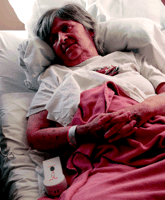This week in the BMJ
Volume 331,
Number 7525,
Issue of 12 Nov 2005
![[Down]](/icons/down.gif) Millennium development goals: time to reassess strategies
Millennium development goals: time to reassess strategies
![[Down]](/icons/down.gif) Maternal and neonatal health: universal access is imperative
Maternal and neonatal health: universal access is imperative
![[Down]](/icons/down.gif) Elderly patients don't need to wait in hospitals for residential care
Elderly patients don't need to wait in hospitals for residential care
![[Down]](/icons/down.gif) Stillbirths could be better classified
Stillbirths could be better classified
![[Down]](/icons/down.gif) Irish smoking ban protected non-smoking bar staff
Irish smoking ban protected non-smoking bar staff
Millennium development goals: time to reassess strategies
Five years after the millennium development goals were set, and a third of the way to the 2015 target date, it seems unlikely that the poorest countries will achieve the goals related to health, say Evans and colleagues on page 1133. This article, the first in a series examining the cost effectiveness of strategies to achieve the goals, emphasises the need to assess whether available resources are being spent in the best way. The authors explain what the goals are, what progress has so far been made, and how the World Health Organization assesses cost effectiveness of interventions.
![[To top]](/icons/back.gif)
Maternal and neonatal health: universal access is imperative
Preventive interventions to improve maternal and neonatal health in sub-Saharan Africa and South East Asia are cost effective, but current coverage is insufficient and universal access to these interventions is a must if millennium development goals are to be achieved. In a cost effectiveness analysis of different strategies, Adam and colleagues (p 1107) found that the most effective strategies were the community based newborn care package, an antenatal care package, the presence of skilled attendants at birth, and availability of emergency obstetric and neonatal care around and after birth. Scaling up the assessed interventions to 95% coverage would halve neonatal and maternal deaths in the studied regions.

| |
Credit: PEP BONET/PANOS
|
|
![[To top]](/icons/back.gif)
Elderly patients don't need to wait in hospitals for residential care
An off-site transitional care facility can be a safe alternative to a hospital for elderly patients who are waiting for a residential care bed. Crotty and colleagues (p 1110) randomised 320 patients to waiting in a transitional care facility, where they received a single assessment from a specialist team and appropriate ongoing therapy, or in a hospital. Death rates and rates of transfer back to hospital did not differ significantly between the groups, but patients who waited in transition facilities waited longer for a bed in a long term facility.

| |
Credit: THE IMAGE WORKS/TOPFOTO
|
|
![[To top]](/icons/back.gif)
Stillbirths could be better classified
The high prevalence of fetal growth restriction preceding stillbirth may be hidden by a current classification system. Gardosi and colleagues (p 1113) developed a new classification of stillbirths and compared it with the conventional Wigglesworth classification. The new classification reduced the proportion of unexplained stillbirths from 66% to just over 15%, with fetal growth restriction accounting for almost 60% of previously unexplained stillbirths. Rates of intrapartum asphyxia were also reduced when the new classification was used, from almost 12% to just over 3%.
![[To top]](/icons/back.gif)
Irish smoking ban protected non-smoking bar staff
A smoking ban in the Republic of Ireland was successful in protecting non-smoking bar workers from secondhand smoke. In a before and after study of about 300 participating bar staff in the Republic of Ireland (intervention region) and Northern Ireland (control region), Allwright and colleagues (p 1117) found that concentrations of cotinine in saliva of non-smoking staff dropped by 80% in the republic after a ban on smoking in all indoor workplaces was introduced and, unexpectedly, by 20% in Northern Ireland over the same period. The intervention also seems to have reduced reporting of any respiratory symptoms—this dropped by 17% in the republic and remained steady in Northern Ireland.

| |
Credit: GETTY IMAGES
|
|
![[To top]](/icons/back.gif)
Millennium development goals: time to reassess strategies
Maternal and neonatal health: universal access is imperative
Elderly patients don't need to wait in hospitals for residential care
Stillbirths could be better classified
Irish smoking ban protected non-smoking bar staff


